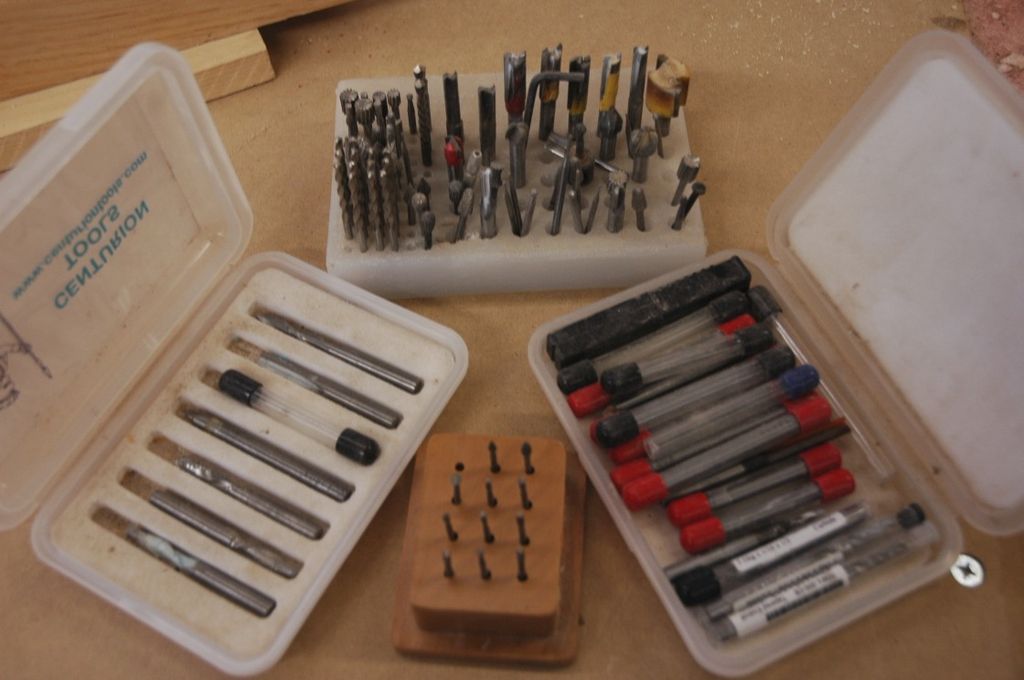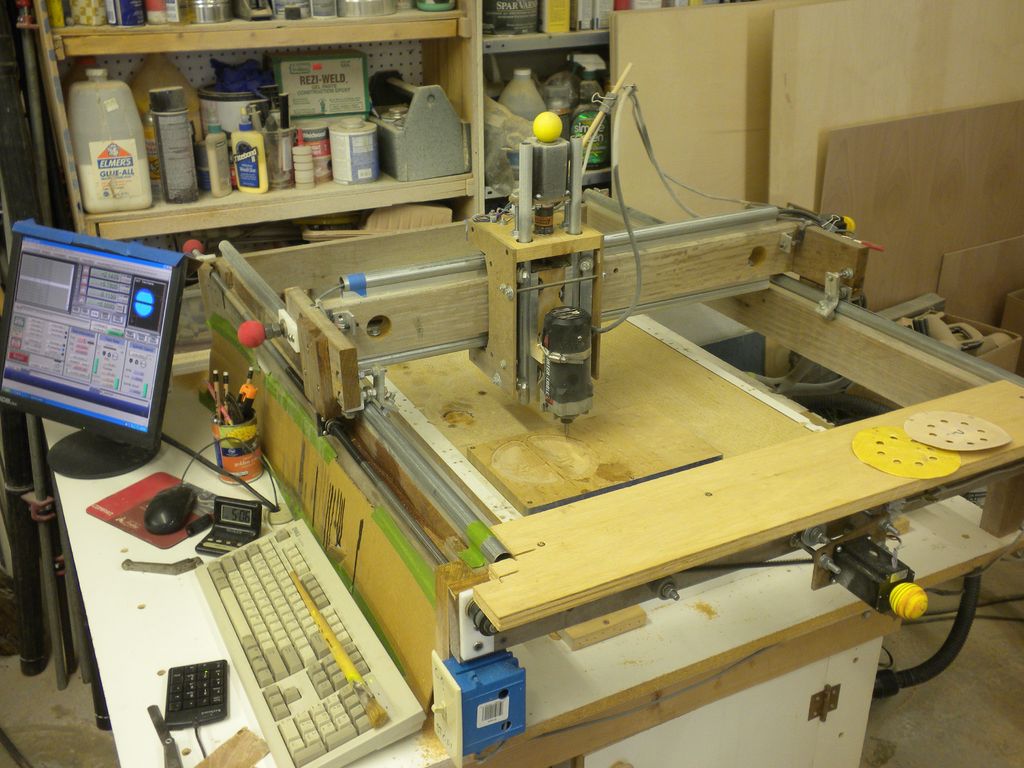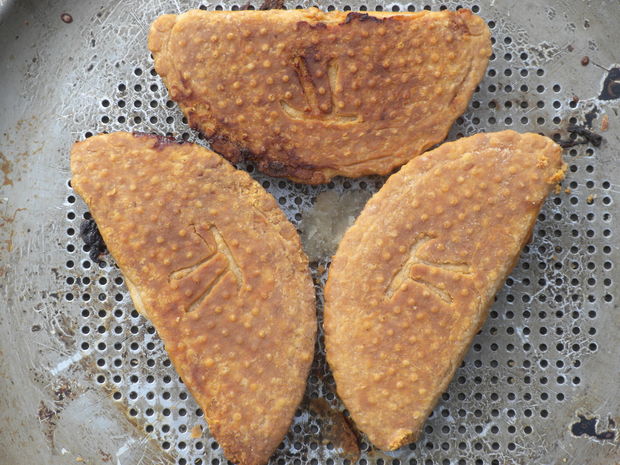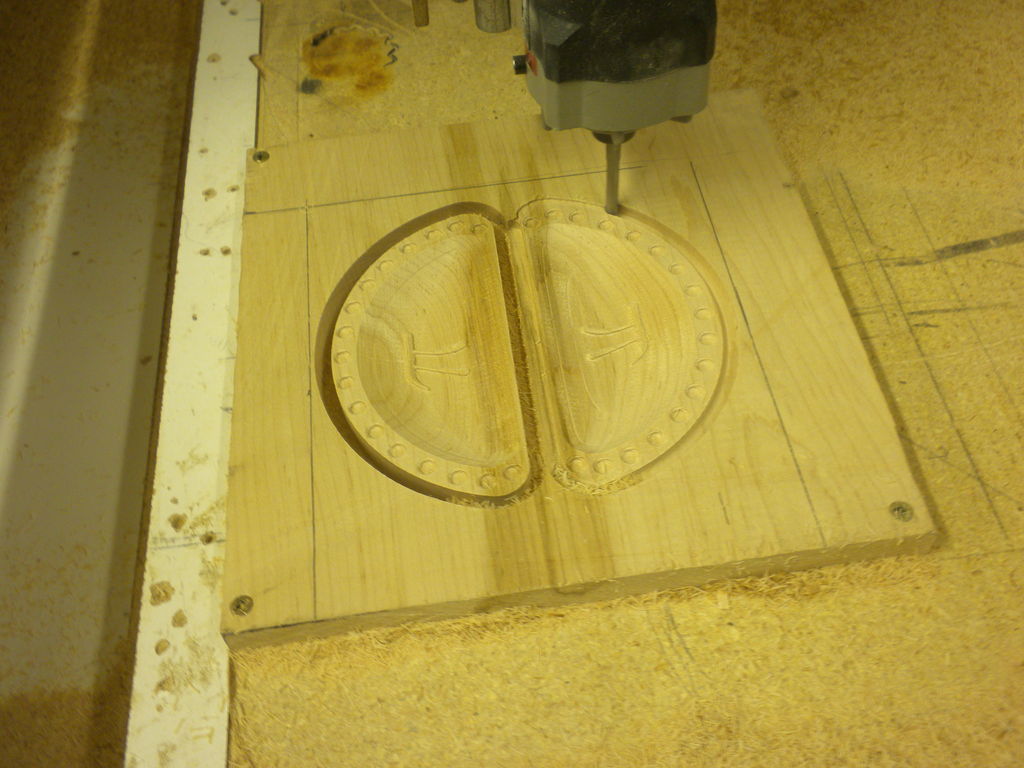Question ID: 4000-13431-0-3-15-16
Recipe Description
CNC STUFF
Computer
Vector drawing program (http://www.freecad.com/CAM_Programs/)
Cam generator (http://www.freecad.com/CAM_Programs/)
Mach3, EMC or similar (http://www.machsupport.com/) (http://www.linuxcnc.org/)
CNC Router or contract fabricator (www.100Kgarages.com)
Tooling bits
Drill
Sanding equipment
Mineral oil
¾ “ Maple or other hardwood
BAKING
All purpose Flour
Butter
Crisco
Sugar
Salt
Egg
Vinegar
Water
Milk
More time, more money, more patience.
Writing skill
Photography skill
Baking Skills
Not necessarily in that order
You can skip down to the baking section if that’s what you’re interested in, but it’s from an amateur. Don’t get your hopes up.
There are so many design programs out there (http://www.freecad.com). Some are free, some are not. Try the free ones, or the trial downloads, and spend some time assessing their capabilities. Make sure you look at what they can import and export. This will be important in moving your drawing files to the CAM generator (more about that later). The higher end ones, have a steep learning curve and take a while to be comfortable with. The lower end and free are getting better all the time. Check out Sketchup (free) with the ruby script that allows output in .stl and .dxf formats. Sweet! (http://www.guitar-list.com/download-software/convert-sketchup-skp-files-dxf-or-stl)
I use several CAD programs depending on my mood and how complex the design will be. This time I used Vectric as the output would ready for the CNC Router.
Starting with a 5" and 6" circle from the same origin, and bisecting it in half, I then separated the two halves with a gap of .5". To round the corners, I created .75" circles and placed them over the sharp parts of the two haves of the larger design, then clipped out the extra vectors. With .5" circles, I repeated the process on the inner 5" diameter halves. Now I had two symetrical parts that had .5" border on the curved portion and .125" at the hinged (straight) edge. For the second version (the first had triangles) I selected a .25" circle, to fill in the wider border. I copied it 34 times and placed them equidistant from each other within the .5" border section. Vectric allows one to covert a 2D vector drawing to 3D, so using their modeling features, I made divots of the small .25" circles and a concave shape of the center section. Lastly I took a pi symbol bitmap, converted it to vectors, placed it in the center of each half of the mold and created a raised (convex) shape.
This sounds difficult , but you can see the result easier than I can describe it.
On our homemade CNC machine is a Porter Cable Trim Router. It will accept ¼” shank bits. I chose a ¼” shank, ¼” end mill for the rough cut, and a ¼” shank, 1/8” ball mill for the finish cut.
Our router only goes one speed in rotation and maxes out at 25 linear inches per minute, so the only control we have is how deep it cuts per pass, and the inches-per-minute speed it travels through the material. As I was to cut maple, a fairly hard wood, and didn’t want to break those expensive bits, I set the toolpath depth to cut just .1” deep on each pass. Also I slowed the feed rate to 12 inches per minute.
Before any machinery is turned on, install the bit into the router you have. Be VERY careful, they are quite sharp. I don’t know anything about bleeding on my project (hah!), but there are a wide range of band-aids and compresses readily available in our shop, just in case.
Most of the time for a test run, I will select blue or grey insulation board. This time chose to skip this part as I wanted to test the result with real dough. Can you imagine all those little bits of foam in a perfectly baked pie? Maybe not such a good plan. If I had started with foam (ignoring the obvious results), it would have allowed me to see how many things I screwed up in the CAM and CAD. It’s also a prototype that can be checked to see if it really looks like what you had envisioned. Lastly, I have a template that may prove useful.
Make sure that the piece you load on the machine is bigger than the project. Additionally I place a sheet of cardboard under the material to protect the bed of the machine. Seems obvious, doesn’t it? Right. Also, make sure that it is oriented correctly in the X and Y plane. I never make those mistakes.
Stabilize the wood. Many treacherous opportunities lie here. Cut the wood larger than the project -- just a reminder). You want extra room for clamping down the outer edges with screws, cam locking devices, or even double-sided tape. In this case I used screws around the outer edges. Regardless of the method, one wouldn’t want the highly rotating router bit or the router itself crashing into something hard and unyielding. Some very interesting results WILL occur and you really don’t want that experience. The least is you may lose some steps in the g-code and get the remainder of the cut all cockety-wampuss, and the worst is flying bits of high speed steel flying around. Which brings us to the all-time favorite subject of OSHA -- Ta-da: SAFETY!
Here we go, ignore this at your own peril.
Ok, the condensed version:
-Ears - CNC machines are loud. I like to put on noise cancelling earphones with my favorite music playing in the background. Not too loud as you want to lightly hear the machine as it runs, giving you a heads-up to any problems.
-Eyes and face – Flying objects do sometimes come from the machine, best to protect them. I use a face shield.
-Breathing – All materials have some dust created during the cut. Use at least a filter mask for non-toxic woods and cardboard something better for MDF and plastics.
(If at all possible make or buy a dust collection system to keep the fumes and dust to a minimum. That’s the next project for us after this contest. Wish I had done it earlier.)
At last the fun begins. Power the machine and computer and open up Mach3 or EMC. These are the interfaces that actually translate the g-code into movement by the router. EMC is the open-source Linux version, Mach3 works with windows. Next load the g-code using a flash drive, wireless or whatever you move files with from your cozy office to the cold and manly shop. Click the Reset button. Now you can move the non-running router around to position the 3D coordinates (X, Y and Z) of the bit by using the number pad on the keyboard.
Now you really want to fire that thing up. You’ve been at it for a while. You’re impatient (well that, at least, describes me at times). But we have to get off on the right foot, or inch, or thousandths of an inch. X, Y and Z must be zeroed. Most of the time, this point will be the topside-lower-left corner of the material. Using the keypad, be slow and careful to NOT run the bit into the material or hold-down clamps. The tooling bits, I’ve found, do break, and are pricey. Once over the zero, lower the bit ever so gently down to just above the top of the piece. Then I place a feeler gauge below the bit and, extremely slowly, move it down to just touch the gauge. Using .002 gets the bit located in space just half-a-hair above the material. You do remember NOT to have the router on during this step, don’t you? Right.
It’s finally time to turn the router on and start the sequence of cutting from Mach3. Just like your mother used to say “don’t forget your mittens,” remember the safety stuff. Turn the router on first. Then click the green button on the screen labeled Cycle Start. You’re off and cutting. Yeah! If it takes off in some bizarre direction, be ready to shut it down by clicking the STOP button. Remember the adage that computers, (along with dangerous machines attached to them) only do what you tell them to do, not what you want them to do. If all is going well, just watch and enjoy the moment. To me, this is amazing stuff, I used to hand cut all of these projects. It’s a wonderful world!
When the cycle ends, and the router comes back to zero, turn it off. Then remove all the screws, or what-have-you that is holding the material firmly. Pick up the piece and be amazed. Remove the waste sections, and vacuum or blow off the dust so the machine is ready for the next fabulous project.
Now is the time to really look at your product. If it looks lousy, go back and try again, even if it means more hours and hours of shop time. Oh the joy! You are doing this for fun, aren’t you?
Most of the time, it takes several iterations and tests to get it right. This one took four tries to achieve the high standards I aspire to. Something like approaching infinity, I’m never quite there.
If yours is perfect, move on down to finishing.
I’ll fly through this part, as I’m sure most of you will have some experience at this. I used an X-Acto knife to clean up feathers left from the cut. Then using foam-sanding pads, and a dremel sanding pad, I smoothed all the surfaces.
Then apply Mineral oil (food safe) to all surfaces and let dry completely. Just an hour or two will do.
Last the hinges must be attached to the two parts. I clamped the parts with about a 1/8” gap (the thickness of a file I had) between them. Then laying the hinges in what looked good to me position, I drilled the holes with a self-centering hinge bit (if you haven’t tried them they are wonderful). I was careful to aim the drill a bit to the side so as not to cut into the cavity. Put the screws in and you are ready to go baking.
If you skipped all that, you’re all right anyway. Here I must say again, I’m NO baker. Luckily I have friends in the restaurant business, cookbooks, and a good wife.
None of them, at first, could figure what to do when the first trials failed. What happened, was that I got a beautiful impression in the dough, but when cooked, all those clear impressions just disappeared. Bummer!
Turns out that as the fats melt, any shape in them or the dough tends to go away, little did I know.
So after checking with those more knowledgeable, a possible solution was tested.
This recipe was sent to me by a fellow friend and Instructable fanatic:
Perfect Piecrust
Mix together in a large bowl:
4 cups all purpouse flour
1 Tbs sugar
2 tsp salt
Add and mix with a fork or pastry cutter till crumbly
1 3/4 cups Crisco or lard or butter (room temperature)
In a small bowl beat together:
1/2 cup cold water
1 Tbs white or cider vinegar
1 large egg
Mix the wet into the dry ingredients with a fork until it just holds together.
Turn out onto the counter and divide into four equal pieces.
Smush each portion into 1" thick patties and wrap with plastic wrap.
Refrigerate until stiff (at least 1/2 hour).
Makes 2 double crust or 4 single crusts.
Can be frozen indefinitely.
I figured out eventually that the dough was sticky, to the counter, to the rolling pin, to me, everything. Then, eureka, I remembered Grandma always threw flour on the counter and pin, and then started rolling. We should remember, they might have had a reason. Well, that worked real well. After rolling the dough out to a big enough size and thickness, I flipped it on top of the mold and pushed the dough down with my fingers, used a spoon to find the pi symbol and cut around it with a knife to expose the image. Then I applied the secret, a band-aid, ie. another piece of dough on the inside.
I took a can of pineapples, drained and drank the juice, then mixed the fruit with some corn starch and brown sugar till it looked good. How much to put in the cavity seemed a trial-and-error sort of thing. Sure enough, I overfilled it the first time and had a mess when the two halves of the mold were squeezed together. The second trial went better.
The oven was set to 350F and the empanada fruit pi was placed on a cookie sheet and put in the oven. Within just a few minutes the pi symbol had gone. I let it cook for 45 minutes just to see if was edible. It was, but the impression wasn’t what I wanted.
This is when another chef gave me the idea to cut the symbol into the dough and place another thin piece of dough on the back (inside) as a sort of band-aid. Well this seemed a bit too fiddly, so being a shop guy not a baker, I went back and re-cut the mold twice more at different depths to see if thicker dough would hold the impression better. No joy, that approach was no better and made a lousy tasting pie.
By now all you experienced cooks and pie makers must be rolling on the floor. This is fun, and now I know a bunch of things that don’t work. Back to my friend’s idea seemed the way to go. By now I was too invested in this concept to walk away and the contest was drawing ever closer.
I went back to the original mold and figured out how to use a spoon to squish the dough down to expose the symbol and carefully cut the dough around it using a knife, then place a band-aid on the inside before filling ( you will see this in Step 14). Way fiddly, but the result was what I was looking for. The last improvement was suggested by my lovely wife. Mixing egg and milk together and brushing it on the dough before cooking gave them a pleasant golden sheen rather than pasty white.
And there you have it. My first attempt to bake a pi.
The press worked extremely well, but trying to emboss images into dough (either positive or negative) was not at all successful.
I think next time, I will make a cookie cutter like device from sheet metal to cut the pi symbol. It might work as well, probably better.
And the band-aid idea---brilliant!
Another Instructable maybe?
Question & Answer
Question: What is the correct order of the images?
Choices:
    |
| (A) |
    |
| (B) |
    |
| (C) |
    |
| (D) |
    |
|---|
 (D) (D) |